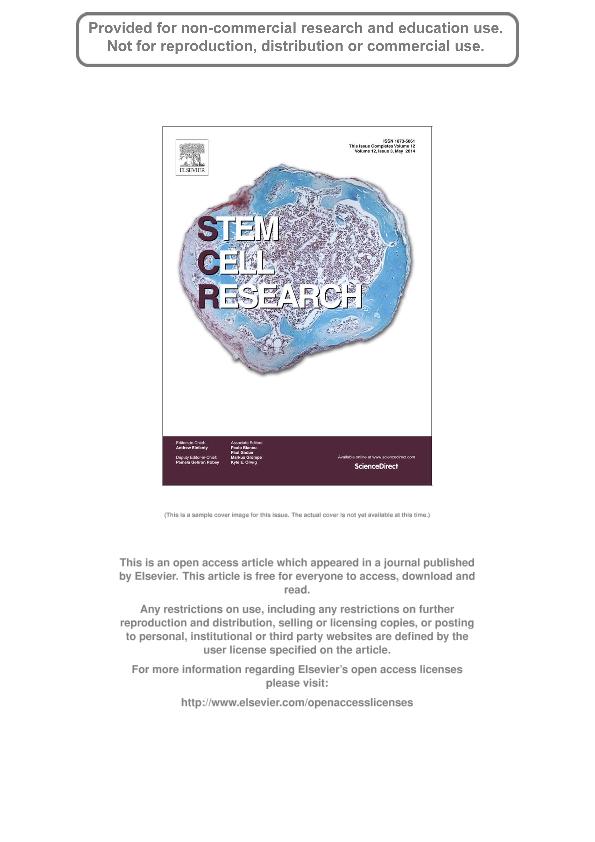Mostrar el registro sencillo del ítem
dc.contributor.author
Mladinic, Miranda
dc.contributor.author
Bianchetti, Elena
dc.contributor.author
Dekanic, Ana
dc.contributor.author
Mazzone, Graciela Luján

dc.contributor.author
Nistri, Andrea
dc.date.available
2018-01-17T18:44:41Z
dc.date.issued
2014-03
dc.identifier.citation
Bianchetti, Elena; Dekanic, Ana; Mazzone, Graciela Luján; Nistri, Andrea; Mladinic, Miranda; ATF3 is a novel nuclear marker for migrating ependymal stem cells in the rat spinal cord; Elsevier; Stem Cell Research; 13; 3; 3-2014; 815-827
dc.identifier.issn
1873-5061
dc.identifier.uri
http://hdl.handle.net/11336/33654
dc.description.abstract
The present study identified ATF3 as a novel dynamic marker for ependymal stem/progenitor cells (nestin, vimentin and SOX2 positive) around the central canal of the neonatal or adult rat spinal cord. While quiescent ependymal cells showed cytoplasmic ATF3 expression, during 6?24 h in vitro these cells mobilized and acquired intense nuclear ATF3 staining. Their migratory pattern followed a centrifugal pathway toward the dorsal and ventral funiculi, reminiscent of the rostral migratory stream of the brain subventricular stem cells. Thus, the chain cell formation was, by analogy, termed funicular migratory stream (FMS). The FMS process preceded the strong proliferation of ependymal cells occurring only after 24 h in vitro. Pharmacological inhibition of MAPK-p38 and JNK/c-Jun (upstream effectors of ATF3 activation) prevented the FMS mobilization of ATF3 nuclear-positive cells. Excitotoxicity or ischemia-like conditions, reported to evoke neuronal and glial injury, did not further enhance migration of ependymal cells at 24 h, suggesting that, at this early stage of damage, the FMS phenomenon had peaked and that more extensive repair processes are delayed beyond this time point. ATF3 is, therefore, useful to identify activation and migration of endogenous stem cells of the rat spinal cord in vitro.
dc.format
application/pdf
dc.language.iso
eng
dc.publisher
Elsevier

dc.rights
info:eu-repo/semantics/openAccess
dc.rights.uri
https://creativecommons.org/licenses/by-nc-nd/2.5/ar/
dc.subject
Atf3
dc.subject
Ependymal Stem Cells
dc.subject
Spinal Cord
dc.subject.classification
Inmunología

dc.subject.classification
Medicina Básica

dc.subject.classification
CIENCIAS MÉDICAS Y DE LA SALUD

dc.title
ATF3 is a novel nuclear marker for migrating ependymal stem cells in the rat spinal cord
dc.type
info:eu-repo/semantics/article
dc.type
info:ar-repo/semantics/artículo
dc.type
info:eu-repo/semantics/publishedVersion
dc.date.updated
2018-01-16T18:05:23Z
dc.journal.volume
13
dc.journal.number
3
dc.journal.pagination
815-827
dc.journal.pais
Países Bajos

dc.journal.ciudad
Ámsterdam
dc.description.fil
Fil: Mladinic, Miranda. Scuola Internazionale Superiore di Studi Avanzati; Italia. University of Rijeka. Department of Biotechnology; Croacia. Istituto di Medicina Fisica e Riabilitazione; Italia
dc.description.fil
Fil: Bianchetti, Elena. Scuola Internazionale Superiore di Studi Avanzati; Italia
dc.description.fil
Fil: Dekanic, Ana. University of Rijeka. Department of Biotechnology; Croacia. Scuola Internazionale Superiore di Studi Avanzati; Italia
dc.description.fil
Fil: Mazzone, Graciela Luján. Scuola Internazionale Superiore di Studi Avanzati; Italia
dc.description.fil
Fil: Nistri, Andrea. Scuola Internazionale Superiore di Studi Avanzati; Italia. Istituto di Medicina Fisica e Riabilitazione; Italia
dc.journal.title
Stem Cell Research

dc.relation.alternativeid
info:eu-repo/semantics/altIdentifier/url/https://www.sciencedirect.com/science/article/pii/S1873506114000336
dc.relation.alternativeid
info:eu-repo/semantics/altIdentifier/doi/http://dx.doi.org/10.1016/j.scr.2014.03.006
Archivos asociados
